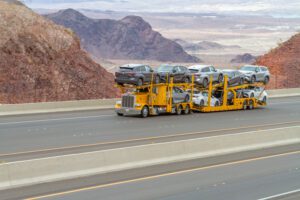It’s clear the United Auto Workers strike against Detroit’s Big 3 manufacturers is both historic and highly uncertain. News headlines paint a picture of two sides having trouble coming to terms, creating a seeming standoff with disruptive ripple effects for many Big 3 suppliers.
For dealers, the possibility of a protracted labor strike is a hot topic of conversation and concern that increasingly extends to the used vehicle department. If you’re a Ford, General Motors or Stellantis dealer, you are probably thinking it’d be wise to stock up on late model used vehicles. If your new vehicle inventory and incoming supply dry up, isn’t it wise to have more late model vehicles in stock to satisfy buyers who want a new vehicle and can’t get one?
hot topic of conversation and concern that increasingly extends to the used vehicle department. If you’re a Ford, General Motors or Stellantis dealer, you are probably thinking it’d be wise to stock up on late model used vehicles. If your new vehicle inventory and incoming supply dry up, isn’t it wise to have more late model vehicles in stock to satisfy buyers who want a new vehicle and can’t get one?
The conversation’s similar for import dealers: If we see an influx of new vehicle buyers, wouldn’t it be smart to hedge lower levels of new vehicle inventory with late model used units?
On the surface, you could make a pretty good case that stocking up on late model inventory right now makes sense. Retail demand for used vehicles is higher than it’s been all year. Current used vehicle inventories on dealer lots are leaner than this time last year. And, there’s the possibility that diminished new vehicle inventory will push retail demand for used vehicles even higher. From a dealer’s perspective, such conditions tend to spur the instinct to “get more cars.”
I’ve been asked if stocking up on late model inventory right now is the right thing to do. It might be, I’ll say. But it could also go the other way: Consumer sentiment has declined significantly in the past two weeks, and it’s been losing ground since July. The development owes to all the worries we see in the headlines—higher gas prices, inflation, student loan repayments, a possible government shutdown, the ripple effects of the autoworkers’ strike.
Is the recent drop in consumer sentiment cause for alarm? I don’t think so. But it certainly suggests that retail demand for used vehicles may weaken and create additional risk for dealers. You don’t want to stock up on late model inventory today and find yourself with too much inventory owned for too much money in late fall and early winter.
On the plus side, though, there’s never been a better time for dealers to make such speculative plays. That’s because today’s technology and tools can tell you when risk is outrunning your potential reward and give you the means to manage your way it.
If I were going to stock up on late model inventory at my dealership, I’d first recognize that I’ll likely need to purchase the vehicles from the auction for top dollar. With Variable Management and ProfitTime GPS, I’d know these vehicles were investment-distressed (i.e., Bronze) compared to other units. I’d then have the benefit of pricing recommendations to help me move each vehicle as quickly as it should to optimize my return.
Beyond that, I’d also have several metrics to inform how well I’m doing overall as I take in and manage the additional inventory:
The spread between my rolling 30-day total of retail sales and current inventory. When I bring in additional late-model vehicles, my inventory count will increase. That’s OK unless and until my rolling 30-day total of retail sales fails to keep pace with my inventory. When your inventory level and rolling 30-day total of retail sales fall out of balance, it’s typically your first sign of potential trouble.
Pricing alignment—Bronze vehicles. If I see a high percentage of price alignment on my Bronze vehicles, I would know that I’m consistently accepting ProfitTime GPS recommendations that help me optimize each vehicle’s return. If the alignment percentage is low, I’d want to examine the cars that are out of alignment to know if the market’s changed or it’s a case of intentional misalignment, wherein a manager had a strategically sound reason to override a pricing recommendation.
Days to Sell/Days in Inventory—Bronze vehicles. These metrics provide another way to tell if a risk-prone segment of inventory is or isn’t moving at the pace it should. Generally speaking, dealers who manage Bronze vehicles most proficiently and profitably maintain both metrics around 30 days.
Before I close, I should add another consideration to this stock-up-now conversation: Dealers who choose not to take on additional inventory right now can still play to a run of higher-than-expected demand for late-model vehicles as it takes shape. The key will be making sure your appraising and acquisition teams know that late-model vehicles are a higher strategic priority, and they work your direct-from-customer acquisition channels to acquire them whenever they can.
The post How to Best Manage the Urge to “Buy Some Cars” Right Now appeared first on Dale Pollak.





